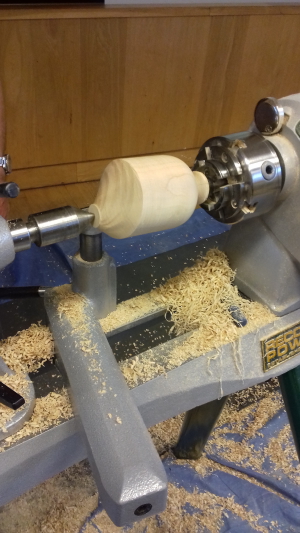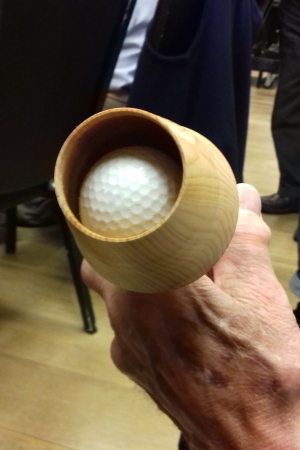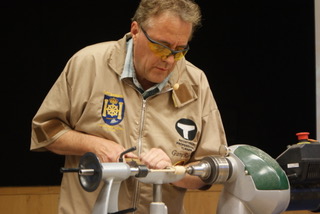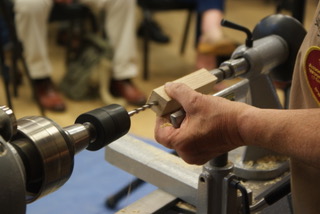Clem Ansell joined us for the evenings demonstration and after a brief introduction Clem commenced to demonstrate the making of a small lidded box that he makes as “Tooth Fairy Boxes” which have proved popular at craft fairs.
The manufacture of this box in sycamore follows the basic principles of box making with the lid recessed into the body. The body was hollowed out to accommodate a £1.00 coin and the largest of the child’s teeth. The outside was shaped to a pleasing form and finished with sanding sealer and carnuba wax which was applied directly to the work in this instance. With larger pieces of work he would not apply it directly as there is a tendency for lines to occur which are difficult to remove. Such pieces would be buffed using carnuba wax on a buffing wheel.
The final flourish was to pyrograph on the outside “TOOTH FAIRY BOX” or whatever other text or picture you want to show. With practice this can become a quick and satisfying project for craft sales.
The next item that Clem demonstrated was a hedgehog which doubles up as a pencil / crayon holder, ideal for a child’s desks etc. This project incorporated off centre turning which was interesting. The square section blank was mounted off centre to start with so that when turned it left a flat spot which will be where the hedgehog lies. (Although on this occasion Clem forgot this part of the process so turned out a cylinder). Once the blank is turned out, the end at the headstock is rounded off to create the rear of the hedgehog. Once sanded and finished the blank was set off centre at the tailstock end approximately halfway from centre to the outside. This is then turned to an angle to create what will be the face.
This project incorporated off centre turning which was interesting. The square section blank was mounted off centre to start with so that when turned it left a flat spot which will be where the hedgehog lies. (Although on this occasion Clem forgot this part of the process so turned out a cylinder). Once the blank is turned out, the end at the headstock is rounded off to create the rear of the hedgehog. Once sanded and finished the blank was set off centre at the tailstock end approximately halfway from centre to the outside. This is then turned to an angle to create what will be the face.
The nose is left as a button and once complete is sanded and finished. The nose is then blackened and eyes drawn on with a sharpie pen. The final operation was to drill several holes randomly in the back into which pencils can be inserted.
There was a little time left so Clem made another small project of a captive golf ball in a goblet form. The blank was set between centres, turned to round and a spigot created. This was then mounted in the chuck and the end hollowed out roughly to just smaller than the golfball diameter but about 20mm deeper. This will allow the golfball to be inserted fully with plenty of clearance. The rest of the hollowing was undercut to slightly larger than the golfball diameter again for clearance but the opening was only turned out to just smaller than the golfball diameter. This allowed Clem to push fit the ball into the socket. He then turned the outside form. Unfortunately he ran out of time so could not finish the item but it did show how it was made. These have proved popular with golf clubs as trophies for “holes in one”.
Unfortunately he ran out of time so could not finish the item but it did show how it was made. These have proved popular with golf clubs as trophies for “holes in one”.
Overall, although the projects were small ones, there was plenty of interest and tips that we can take away, practice and hopefully elaborate on.




